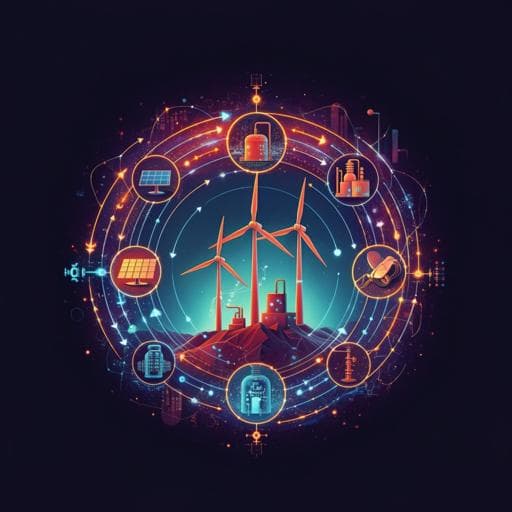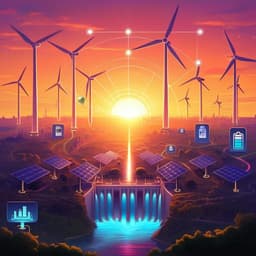
Environmental Studies and Forestry
The role of natural gas in reaching net-zero emissions in the electric sector
J. E. T. Bistline and D. T. Young
This study by John E. T. Bistline and David T. Young explores how natural gas and carbon removal can drive down the costs of decarbonizing the electric sector in the U.S. Discover how wind and solar energy are expected to dominate generation shares over natural gas in most scenarios!
~3 min • Beginner • English
Introduction
The power sector is expected to play a central role in economy-wide decarbonization, both through direct emissions reductions and through end-use electrification. Natural gas has historically contributed to emissions reductions in many regional U.S. power systems, yet its near- and long-term roles under deep greenhouse gas reductions—especially net-zero targets where residual emissions are balanced by carbon removal—remain uncertain. Utilities’ net-zero pledges often include new gas-fired capacity, raising questions about gas levels consistent with electric sector decarbonization goals. Previous work has examined gas in emissions reduction, but not explicitly reaching zero-emissions goals or accelerated timetables aligned with the U.S. target of 100% carbon pollution-free electricity by 2035, and technology cost expectations have evolved. The objective here is to assess the potential role for natural gas and carbon removal in deeply decarbonized U.S. electricity systems and test robustness to key technology and policy assumptions. Using an hourly-resolved, detailed energy systems model, the study evaluates investment and operational decisions, sector coupling, and a wide suite of technologies. The analysis finds natural gas capacity and generation can play key roles in least-cost decarbonization—both during the transition and at net zero—depending on policy design, carbon removal availability, upstream methane mitigation, and technological transition risks.
Literature Review
Prior studies (e.g., Shearer et al. 2014; McJeon et al. 2014; Gillingham & Huang 2019; Woollacott 2020; EMF 32) examined how natural gas affects power-sector emissions and renewable deployment but did not focus on achieving zero emissions or accelerated 2035 timelines. Since earlier analyses, expected cost declines for renewables and storage and natural gas price outlooks have changed. More recent literature emphasizes the role of firm low-carbon resources in deep decarbonization and the importance of temporal resolution and endogenous load shapes. This study extends the literature by: modeling zero-emissions goals (Net-Zero vs Carbon-Free), exploring acceleration to 2035, incorporating hourly resolution with sector coupling and endogenous end-use decisions, representing a broad technology set including BECCS and DAC, and testing robustness across extensive sensitivities (technology costs, fuel prices, methane leakage, CCS incentives, long-duration storage, and policy design).
Methodology
The study uses EPRI’s US-REGEN model—an energy systems framework linking an electric sector capacity planning and dispatch model to an end-use model—with full hourly resolution and regional detail. The electric-sector component is a linear program minimizing net present system costs subject to technical and policy constraints, with endogenous investment and dispatch decisions for generation, storage (batteries, CAES, pumped hydro), inter-regional transmission, hydrogen production/storage/use, and CO₂ removal, transport, and storage. Technologies represented include multiple solar PV configurations (fixed, single-, double-axis), concentrating solar with thermal storage, onshore/offshore wind, geothermal, nuclear (Gen III+ and SMRs), hydropower, biomass, hydrogen-fired units, and thermal plants (coal, gas, biomass) with/without CCS. Endogenous conversions (coal-to-gas/biomass) and CCS retrofits are allowed. Storage power/energy sizing is optimized; batteries’ inverter charge/discharge capacities are equal; storage participates in energy arbitrage, capacity, operating reserves (when specified), and transmission deferral. Hydrogen pathways include electrolysis (capex assumed $200/kW with endogenous electricity cost), storage (assumed $50/MMBtu, akin to salt caverns), and hydrogen turbines. Hourly renewable profiles and resource potentials derive from EPRI/AWS Truepower/NASA MERRA-2 (single meteorological year 2015) synchronized with hourly end-use load. Interregional transmission starts from NREL REEDS capacities; expansion is endogenous at $3.85 million/mile for a 6,400 MW notional HV line; wind and solar interconnection costs are $250/kW and $100/kW, respectively. Fuel and cost inputs: natural gas price paths from EIA AEO (Reference, High, Low); biomass via regional supply curves from FASOM-GHG; technology cost trajectories summarized in Supplementary Fig. 4. The emissions intensity of natural gas includes upstream CH₄ with a 1.5% leakage assumption (100-yr GWP=25); a 3% leakage sensitivity is tested. Carbon dioxide removal options include BECCS (negative-emissions firm power) and DAC; a 45Q sensitivity applies $32/t-CO₂ (2020) rising to $50/t-CO₂ (2026) for geologic sequestration. Policy scenarios: Reference (on-the-books federal/state policies as of June 2021, including RPS/CES, offshore wind/storage mandates, CA AB32 pricing, PTC/ITC phaseouts, RGGI, and effective prohibition on new coal without CCS; some nuclear prohibitions), Net-Zero (remaining electric-sector CO₂ emissions must be offset via sequestration), and Carbon-Free (no fossil or emitting generation operating at/after target year). Targets: 2035 and 2050 (with interim 80% below 2005 by 2035 for 2050 cases). Sensitivities (not exhaustive): LORE (faster declines in wind/solar/battery costs), HiCapture (higher CCS capture-rate capable gas tech with flue gas CO₂ like air at cost similar to 90% capture), NoGas (no new NGCC after 2020), NoGasCCS (no new NGCC or CCS-equipped capacity after 2020), 3% Leak (higher upstream CH₄ leakage), 45Q (CCS tax credits), LDES (long-duration storage with $10/kWh energy capacity), Pess (pessimistic gas assumptions: high CH₄ leakage, high gas prices, high BECCS cost, no DAC, high CO₂ storage costs; optimistic renewables/storage/electrolyzer costs). Sector coupling and end-use: The end-use model generates annual demand and hourly load shapes endogenously, assuming non-electric CO₂ pricing at $50/t-CO₂ in 2025 rising 7%/yr (proxy for economy-wide policies) for core scenarios; deferrable EV charging participation is 50% residential and 80% workplace. Two electrification variants are run: Reference electrification (RefEl) and High electrification (HiEl, with $100/t-CO₂ in 2025 escalating 10%/yr plus faster technology cost declines and adoption). The electric and end-use models iterate (hourly prices to end-use; hourly loads back to electric) until convergence. Results are evaluated nationally and by region, with metrics including generation/capacity mix, investments/expenditures, prices, marginal abatement costs, capacity factors, and CDR deployment.
Key Findings
- Natural gas lowers decarbonization costs when carbon removal is allowed. Under Net-Zero policies, inclusion of gas (with CCS or offset via CDR) reduces required capacity additions and expenditures relative to Carbon-Free designs that prohibit gas and CCS.
- Investment and cost savings: By 2035, Carbon-Free requires over ~1300 GW cumulative new capacity (solar, wind, nuclear, hydrogen, batteries) with generation expenditures of ~$1.6T, whereas Net-Zero reduces new capacity to ~1000 GW and generation+bulk transmission expenditures to ~$1.3T.
- Electricity prices: For 2035 decarbonization, Carbon-Free raises generation-weighted average prices by ~45–104% (vs. Reference), while Net-Zero reduces that increase to ~38–80% depending on region. A 2050 target lowers prices relative to 2035 due to assumed lower capital costs and gradual transitions.
- Marginal abatement costs (shadow prices): Approaching zero without CDR is extremely costly (~$48,000/t-CO₂ by 2035 in Carbon-Free). With CDR under Net-Zero, marginal costs align with BECCS costs: ~$107/t-CO₂ (LoRE) to ~$126/t-CO₂ (Pess).
- Generation shares: Wind+solar dominate generation in Net-Zero scenarios (52–66%), while natural gas contributes 0–19% of generation. Natural gas has a larger capacity share (8–32%) than generation share, reflecting a shift from energy provision to firm, flexible capacity as decarbonization deepens.
- Gas capacity and utilization: Demand for natural gas capacity spans ~160–590 GW across Net-Zero scenarios (2035). NGCC capacity factors decline by ~50% from current levels as units operate more like peakers; CCS-equipped gas exhibits higher capacity factors (55–75%) than unabated NGCC (0–70%), depending on region/scenario.
- Role of CDR: BECCS provides modest generation but substantial negative emissions, roughly triple the positive emissions from unabated NGCC in the reference Net-Zero case (about 150 TWh BECCS vs 520 TWh NGCC). DAC deployment rises under alternate assumptions (e.g., higher biomass costs or higher demand).
- Policy design matters: Prohibiting new gas or CCS (NoGas, NoGasCCS, Carbon-Free) suppresses gas deployment, increases costs, and shifts portfolios toward more nuclear, hydrogen, and renewables/storage. Allowing higher-capture CCS (HiCapture) or maintaining low methane leakage (NZ Ref) increases gas competitiveness; breakthroughs in long-duration storage (LDES) or lower renewables/battery costs (LORE) reduce gas deployment.
- Regional heterogeneity: Regions with lower-quality renewables (East, South) rely more on gas under Net-Zero and face higher price impacts without gas. The South shows the highest NGCC+CCS deployment (Net-Zero) and higher nuclear in Carbon-Free. Gas displaces coal across all regions under deep decarbonization.
- Acceleration effects: Accelerating to 2035 increases absolute and relative gas contributions (more CCS-equipped gas, wind, nuclear; less solar and batteries) compared to 2050 targets where falling costs favor solar and storage.
- Electrification impacts: Higher electrification increases 2035 generation from solar, wind, gas, and nuclear under Net-Zero/Carbon-Free; by 2050, greater electrification plus lower solar/storage costs reduce gas generation and CDR needs due to enhanced competitiveness and load-shape flexibility.
- Hydrogen: Despite interest in hydrogen-capable turbines, hydrogen’s power-sector role remains modest under many scenarios due to higher marginal abatement costs (e.g., ~$90/t-CO₂ for $1/kg H₂ and $4/MMBtu gas before upstream emissions).
Discussion
The findings address the central question of natural gas’s role in achieving net-zero electricity by demonstrating that, under a Net-Zero framing that permits carbon removal, gas capacity—paired directly with CCS or indirectly offset by CDR—can reduce system costs, support reliability, and complement high shares of variable renewables. Policy design is pivotal: a Carbon-Free framing that prohibits gas and CCS greatly increases costs and electricity prices and shifts portfolios toward larger deployments of nuclear, renewables, storage, and hydrogen. As decarbonization deepens, gas shifts from supplying energy to providing firm capacity and flexibility, with capacity factors falling and revenue streams concentrating in fewer, higher-value hours. Regional resource quality drives heterogeneity: areas with poorer wind/solar resources show higher gas shares and greater cost penalties if gas is disallowed. The results highlight the importance of CDR, particularly BECCS, to balance residual emissions from unabated gas and other sources at reasonable marginal costs; DAC plays a larger role as biomass costs rise or demand scales. The analysis underscores technology transition risks and upstream methane mitigation: higher leakage erodes gas’s role, while innovations in CCS or long-duration storage can shift the least-cost mix. Overall, natural gas need not be a stranded asset under Net-Zero design; its value migrates toward reliability services and firm capacity in support of a renewables-dominated grid.
Conclusion
This study contributes evidence that natural gas, when coupled with carbon removal, can be part of least-cost pathways to net-zero electric systems in the U.S., lowering required capacity additions and expenditures and moderating electricity price increases compared with Carbon-Free designs that exclude gas and CCS. Wind and solar provide the majority of generation in Net-Zero futures, while gas retains a larger capacity footprint to backstop variability. The role of gas is sensitive to policy framing, technology costs and availability (CCS, long-duration storage, renewables), and upstream methane emissions. Regional differences in renewable resource quality and existing infrastructure shape gas competitiveness and costs. Future research should: incorporate detailed operational constraints and ancillary service requirements as inverter-based resource shares grow; examine market design implications of higher price variability and revenue concentration for firm capacity; and extend analysis to net-zero economy-wide pathways, including comprehensive treatment of hydrogen blending/retrofits and multi-year climate/weather variability.
Limitations
- Fuel price paths are exogenously specified rather than endogenously modeled.
- Operational constraints (e.g., inertia) and detailed ancillary services markets are not explicitly represented.
- Hydrogen is modeled only for new investments, not for blending/retrofits of existing units.
- Temporal resolution is hourly; subhourly dynamics and detailed transmission/distribution constraints are not modeled (though costs are included).
- A single historical weather year (2015) underpins synchronized resource and load profiles; multi-year variability is not captured.
- Findings are tailored to U.S. conditions (low-cost gas, abundant biomass, high-quality renewables, ample CO₂ storage) and may not fully generalize to other regions with different resource and infrastructure constraints.
- Lifecycle emissions beyond upstream CH₄ leakage (assumed 1.5% with a 3% sensitivity) are not included for generation technologies or fuels.
Related Publications
Explore these studies to deepen your understanding of the subject.







